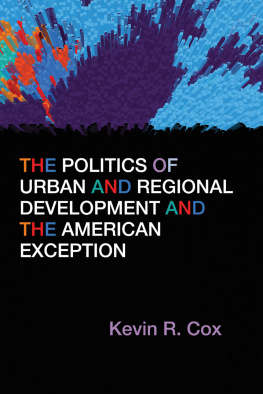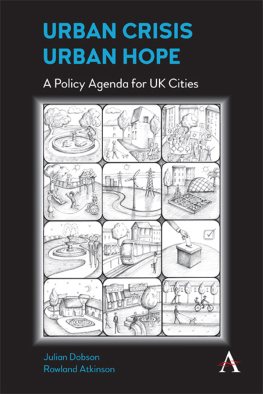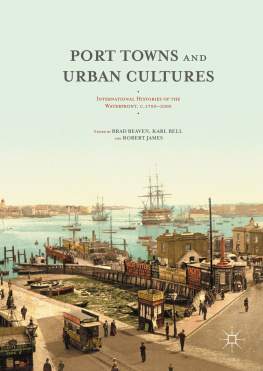ROUTLEDGE LIBRARY EDITIONS:
URBAN STUDIES
Volume 1
THE BRITISH NEW TOWNS
THE BRITISH NEW TOWNS
A programme without a policy
MERYL ALDRIDGE
First published in 1979 by Routledge & Kegan Paul Ltd
This edition first published in 2018
by Routledge
2 Park Square, Milton Park, Abingdon, Oxon OX14 4RN
and by Routledge
711 Third Avenue, New York, NY 10017
Routledge is an imprint of the Taylor & Francis Group, an informa business
1979 Meryl Aldridge
All rights reserved. No part of this book may be reprinted or reproduced or utilised in any form or by any electronic, mechanical, or other means, now known or hereafter invented, including photocopying and recording, or in any information storage or retrieval system, without permission in writing from the publishers.
Trademark notice: Product or corporate names may be trademarks or registered trademarks, and are used only for identification and explanation without intent to infringe.
British Library Cataloguing in Publication Data
A catalogue record for this book is available from the British Library
ISBN: 978-1-138-89482-2 (Set)
ISBN: 978-1-315-09987-3 (Set) (ebk)
ISBN: 978-1-138-04753-2 (Volume 1) (hbk)
ISBN: 978-1-315-17073-2 (Volume 1) (ebk)
Publisher's Note
The publisher has gone to great lengths to ensure the quality of this reprint but points out that some imperfections in the original copies may be apparent.
Disclaimer
The publisher has made every effort to trace copyright holders and would welcome correspondence from those they have been unable to trace.
The British new towns
A programme without a policy
Meryl Aldridge
Routledge & Kegan Paul
London, Boston and Henley
For my parents
Kenneth and Betty Horrocks
Contents
First published in 1979
by Routledge & Kegan Paul Ltd
39 Store Street, London WC1E 7DD,
Broadway House, Newtown Road,
Henley-on-Thames, Oxon RG9 1EN and
9 Park Street, Boston, Mass. 02108, USA
Set in 10/11 Times by
Oxprint, Oxford
and printed in Great Britain by
Lowe and Brydone Ltd
Thetford, Norfolk
Meryl Aldridge 1979
No part of this book may be reproduced in
any form without permission from the
publisher, except for the quotation of brief
passages in criticism
British Library Cataloguing in Publication Data
Aldridge, Meryl
The British new towns. (International library of sociology).
1. New towns Great Britain
2. Urban policy Great Britain
I. Title II. Series
309.2'62'0941HT169.G77940866
ISBN 0 7100 0356 0
Background
Between 1969 and 1972 I was involved, with three colleagues at the University of Birmingham Centre for Urban and Regional Studies, in an SSRC financed project originally concerned with the planning process and the development of new communities. During the three years, the objective of the study was narrowed to the more manageable one of studying social development staff in British new towns and in some expansion schemes and elsewhere. The four members of the research team visited all the new towns between them, and therefore became familiar not only with the post-war decentralization policy expressed through the New Towns Act and the Town Development Act 1952, but with the physical and aesthetic qualities of the towns themselves.
After I left the Centre and moved into a teaching post I found, as is often the case, that my interest in the new towns policy was increased rather than diminished, reinforced by requests from colleagues to do the new towns for their courses of lectures and seminars. Students seem fascinated by the whole idea of new towns, so while I enjoyed being a pundit on the topic, I became increasingly frustrated by the literature available. Attempts to deal with the policy from a detached and evaluative perspective have been few. Some are now historical documents (Orlans, 1952; Rodwin, 1956). More recent appraisal is scattered amongst journals (Heraud, 1966 and 1968) or government papers of daunting scale and detail (Cullingworth and Karn, 1968; Expenditure Committee, 1974 and 19745a). The annual reports of the development corporations and occasional parliamentary debates are also rich potential sources of data, but finding enough material with which to construct an argument is rather like panning for gold, and not an activity that a teacher can reasonably expect of a student preparing for a seminar or an essay.
There are, of course, a number of recent books dealing with the British new towns, notably: Evans (1972), Osborn and Whittick (1969) and Schaffer (1972). All are lively and informative, but all overlook or evade discussion of the more controversial elements of the policy. They have also tended to emphasize continuities rather than changes and contradictions, and to reject examination of that aspect of new towns policy which to a sociologist is most fascinating: its ideological content. This book is an attempt to rectify this, from a position of detachment, although the new towns defy impartiality. They have a fascination which arouses emotions powerful enough to transcend the turgid format of annual reports and select committee hearings. Simply reading and writing about new towns provides some insight into why people should devote a lifetime to their cause.
The book does not attempt to deal with the history or objectives of particular new towns. For this, the reader should turn to Osborn and Whittick (1969), Schaffer (1972) and Thomas (1969a and b).
Northern Ireland new towns are omitted from the discussion, because their circumstances, and in particular their local government powers, bear no comparison with those in the rest of the United Kingdom.
The plan of the book
contains a review of the main themes and some remarks about the future.
is a highly selective outline history of the early years of the garden city movement, concentrating on the philosophy of Howard himself and that of his most influential successor, F. J. Osborn. The growth of the Garden City Association into a highly effective lobby in the years 1918 to 1939 is sketched. The chapter concludes with the mounting public concerns in the 1930s about regional imbalances of wealth and the consequences of large-scale housing development. Readers with a particular interest in the historical background to the new towns may also wish to refer to Howard himself (1965) and to Ashworth (1954), Cherry (1972), Petersen (1968) and Purdom (1949). (The last describes in detail the building of Letchworth and Welwyn Garden City.)
examines the recommendations of the three famous wartime committees: Barlow (1940), Scott (1942) and Uthwatt (1942). It then moves on to review both the recommendations and the underlying philosophy of the New Towns Committee (1946a, b and c) under Lord Reith, suggesting that wartime conditions produced a vision of new towns more centralized and collectivist than that of the earlier propagandists and yet equally apolitical.
The development of the Mark One new towns between 1946 and 1959 is examined in . During this early period certain crucial characteristics of the new towns were established, notably a tendency to high rents and a concentration on industrial development, together with the rigid application of employment criteria for housing allocation. Despite this, the relations of the ministry concerned and the Board of Trade remained informal.








